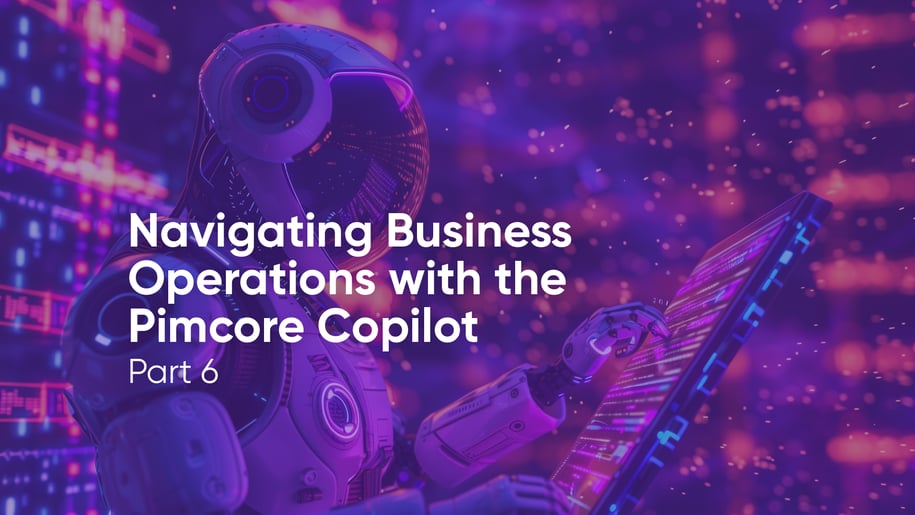
Discover how fine-tuning AI models with Pimcore Copilot helps businesses optimize their data accuracy and relevance across platforms, improving efficiency and outcomes.
Maximizing AI Potential for Your Business
When managing vast amounts of data across different platforms, the challenge isn’t just about organizing information—it’s about ensuring accuracy, relevance, and efficiency. Especially when dealing with product classifications or asset management, relying on general AI models may not deliver the specificity and accuracy your business requires. That’s where fine-tuning an AI model with your data can make a difference, ensuring the model understands your unique business needs. Pimcore Copilot is a practical solution, making this process easier and more accessible, even for non-technical users.
The Challenge: Specialized Needs, General Solutions
Using off-the-shelf AI models often comes with limitations. While these models are great for general tasks, they may fall short when it comes to assigning specific attribute values to products or assets—mainly when the requirements are unique to your industry or business. What works for one company might not work for yours. That’s why fine-tuning AI models is crucial. By tailoring the AI to your own data, you can ensure the output is highly relevant, accurate, and aligned with your business goals.
The Solution: Customizing AI Models for Precision
Consider fine-tuning an AI model based on your business’s specific needs to achieve the best results. Pimcore Copilot allows you to do just that—whether you prefer to follow your own fine-tuning process or use the predefined action steps provided in the Pimcore Copilot Showcase bundle. These steps are designed to get you up and running quickly, making optimizing the AI model for your unique data easy.
Starting with Pimcore Platform Version 2024.3, Pimcore Copilot includes a set of pre-configured actions that guide you through fine-tuning an AI model with your own data, all while staying within the Pimcore platform. Additionally, Pimcore offers a Hugging Face space where you can execute the fine-tuning process and store the fine-tuned model in Hugging Face Hub for future use.

The Process: Step-by-Step Fine-Tuning with Pimcore Copilot
Fine-tuning your AI model may sound complex, but Pimcore Copilot makes the process approachable with clear steps. These actions can be tailored to fit your needs:
- Start or Stop a Specific Hugging Face Space for Training: Initiates the environment, enabling you to start training the AI model.
- Prepare Training Data for Texts: Generates a CSV file from your data objects, creating the foundation to train the AI model for text-based content.
- Prepare Training Data for Assets: Creates a zip file with thumbnails organized into folders based on tags, making it easier to train the AI model for image recognition.
- Start Training for Assets or Texts: Once your data is ready, you can begin training text and visual content.
- Clean Up Temporary Files: After completing training, this step helps you tidy up by deleting unnecessary files.
Let’s see what fine-tuning a Hugging Face AI model looks like
.. and how to use a fine-tuned model in Pimcore Copilot
New Action Steps for Leveraging Fine-Tuned AI Models
Once you've successfully fine-tuned your AI model, Pimcore Copilot provides two key action steps that allow you to harness the power of your model:
- AI Text Classification: This feature enables the AI model to automatically classify and assign attribute values to various data objects. It’s more flexible and nuanced than general models because it’s been trained on your needs. Whether tagging products or categorizing information, this action offers tailored precision.
- AI Image Classification: Similar to text classification, you can use your fine-tuned AI model to classify and tag images more specifically. Instead of relying on predefined categories that may not fit your business, this step allows for a broader range of tagging options, giving you more relevant and valuable results.
In contrast to the 'Hugging Face Zero-Shot Actions,' these two new actions are not restricted by a fixed set of classifications and don’t have limitations regarding the diversity of results they can provide. These steps go beyond the limitations of traditional AI models, providing you with a more customized and effective way to handle your business’s unique data classification needs.
Included Actions | Pimcore Development Documentation
Hugging Face Fine-tune Models | Pimcore Development Documentation
Did You Know?
Pimcore Copilot also supports multiple levels of permissions to ensure that users only have access to the functionalities they need.
General Permissions
- Pimcore Copilot Bundle – Pimcore Copilot allows users to start the Copilot using a simple key binding.
- Pimcore Copilot Bundle – Configuration lets you customize and configure actions in the backend.
- Pimcore Copilot Bundle – Job Run Overview gives you access to view and manage the tasks executed by your team or users.
Specific Permissions
For more complex setups, permissions can even be action-specific, allowing you to assign different access levels for each task based on a user’s role or department.

Unlocking Limitless Possibilities with Pimcore Copilot
With Pimcore Copilot, fine-tuning AI models to meet your specific business needs has never been easier. Whether you're classifying texts or images, you can now enjoy the precision and flexibility of a model tailored specifically for your data. Clear action steps in Pimcore Copilot and the ability to control permissions offer endless possibilities for optimizing how you handle data across your organization.
Keep an eye out for more blog posts that will help you explore the full potential of Pimcore Copilot!



